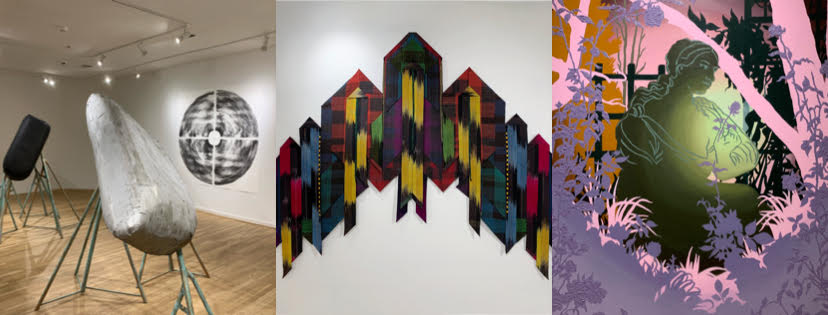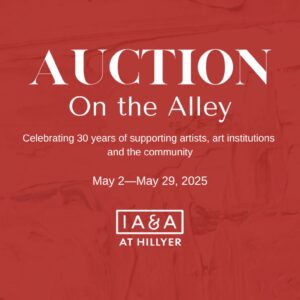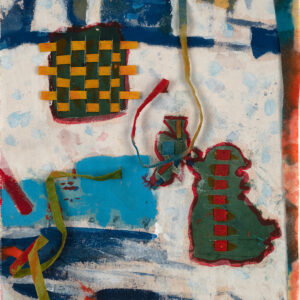by Timothy Brown
The ideas that inform our understanding of contemporary art are often intertwined with the materials and processes that are used to create art, as well as the content they represent. These approaches find singular expression in the work of Michael Thron, Hillary Steel, and MK Bailey.
A General View of Concepts
“Cogito Ergo Sum” (I think, therefore I am) — René Descartes
Concepts are associated with ideas, mental formulations that are independent of material form or referent (rationalism). For instance, the concept of beauty remains resolute as an idea, whereas the material form (e.g., the word “beauty” or a “flower”) can take on many guises. As Shelley wrote, “The one remains, the many change and pass.” Concepts, in this sense, do not derive their essential meaning from representations.
A General View of Material Form
“Every effect is a distinct event from its cause. It could not, therefore, be discovered in the cause, and the first invention or conception of it, a priori, must be entirely arbitrary.” — David Hume
Material form refers to any kind of representation that can be used as the basis for defining some kind of experience or understanding (empiricism). For example, a mountain can be awe-inspiring or evoke ideas of grandeur. In this case, concepts, or “a priori” principles, are not resolute, but temporal, taking on different meanings when engendered by the physical, visual, or auditory presence of a thing.
In the work of modern-day creatives like Michael Thron, Hillary Steel, and MK Bailey, concept and material form are united in dynamic and unexpected ways. Rather than treat idea and representation as mutually exclusive, all three artists explore the fecund tension that results when material representations overlap with their conceptual moorings.

Michael Thron
“The rising seas and temperatures, resource scarcity, and climate-change-fueled migrations (both human and animal) that mark our new age call on us to reconsider both the ideas that define our worldviews and the material culture that codifies everyday experience.”
The conceptual foundation for Michael Thron’s work is climate change, but his sculptural installations evoke rich contradictions that both prefigure and supersede their signification. The installation represents two large ship hulls. Thron mixes tar with sand to coat one hull, recalling a time when tar was used to prevent boats from leaking. Tar, however, becomes an arbitrary sign, once its preventive connotations are vitiated by such adverse associations as emissions and their effect on the environment. This contradiction is likewise revealed through Thron’s use of lead, once used widely as a practical industrial material but now regarded as a dangerous water contaminant.
The context for In the Ways is the harbor—specifically, the manifold impacts on it by land developers, who have indelibly altered the state of our natural resources. Climate change is the core concept, but its meanings encompass both origin and consequence; e.g., how the materials in question can, in this context, oscillate between productive and destructive ends.
Hillary Steel
“Much of the work in the exhibition is showcasing my great concern about the state of our world nationally and internationally. Repair the world is really a call for exactly that, which would include dialogue, honest dialogue, and respectful dialogue.”
Hillary Steel’s exhibition Tikkun Olam is at once a concept and a call to action. Steel is fully conscious of the interdependent nature of concept and material form, and utilizes both to remake the world, rather than destroy it. Like her art, a dialogue (ideally) is about reciprocity and mutual respect. Similarly, the call to action is about process—the mediation and supersession of dual forces that lead to more fruitful outcomes.
It is not surprising that Steel’s medium of choice is textiles, and the age-old technologies of weaving and dyeing. Dialogue is reimagined as the integration of warp and weft. Action is the “shuttle” that brings them together, and the floor looms are her tools for remaking the world and exploring new possibilities. The inevitable tension between concept and material form is echoed by her use of binding and resist-dyeing techniques, which are synthesized by her complex design structures. Dyeing before and after the weaving process (ikat and shibori) further reinforces the notion that mind and matter are not mutually exclusive, but part of a shared process of continual evolution. For Steel, art is not the form of pure content or the content of pure form, but the process that engenders new and hopeful outcomes. The spirit of hope is embodied in the work “Tikkun Olam,” which was inspired by the quetzal bird, a national symbol of liberty for the people of Guatemala.
MK Bailey
“Normally, before I begin a piece, I actually start with the title. When I start with the title, that’s a way of having a propeller for the pieces, so I know what direction they are going in, what concepts and themes to build off of.”
MK Bailey’s Secret Garden highlights a body of work that is tied together through a process of semiosis—paintings as “signs” that are linked by a mural design. Signs, as the embodiment of both concepts and representations, reveal the dialogical way in which Bailey allows ideas to inform her artwork, and vice versa. For instance, the exhibition, originally entitled Outside Eden, was changed when Bailey considered the hidden, remote location of the Hillyer gallery space—a sort of hidden gem. Her ideas are also drawn from dreams, phrases, and song lyrics, which function as visual and auditory signs that inform the development of her compositions.
The reciprocal way in which Bailey integrates ideas into her work is evident in her compositional arrangements and use of color. For example, in Garden of Earthly Delights I and II, the compositions are symmetrical, the hues are bright, and the gestures are dramatic. Yet the figures in each painting stand in stark contrast to one another—one rendered in tints, the other in shades. The concept that seemingly unites the two works takes the form of dyadic signs that are both pleasant and sinister at the same time.
All three artists recognize the inextricable link between their ideas and how they are made manifest. How one informs the other is determined by the medium, the process, and the material world they re-present and reimagine.




